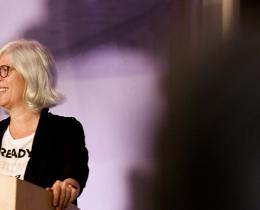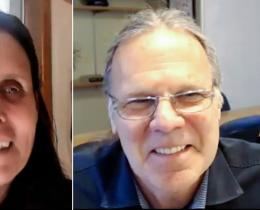The top managers of the Legal Aid Society's Juvenile Rights Practice only get to meet once a month, if that. "We needed time away from our hectic court-based environment to think more clearly, without interruption, and in a supportive environment," says Ann Marie Scalia, attorney-in-charge of the Manhattan Juvenile Rights office. Theirs is not a unique story.
In Washington, D.C., GirlTrek, a national nonprofit focused on helping black women and girls improve their health by walking, was at a turning point. The group was growing exponentially but needed time to plan and figure out the most strategic way to scale and launch their big push to get one million black women "walking in our neighborhoods" by 2018.
In New York State's Orange County, the domestic violence prevention organization Safe Homes identified a need to improve their internal communications and supervisory structure and to incorporate self-care into their institutional culture. That might seem like a luxury, but given the high-stress levels among staff in an extremely challenging environment, it was critical for Safe Homes.
Nonprofits across the country continue to struggle in the wake of the Great Recession to balance rising demand for their services with a lack of adequate resources to meet the needs of society's most vulnerable. In the Nonprofit Finance Fund's 2013 State of the Sector survey, 90 percent of respondents said that financial conditions were as bad or worse for their clients in 2012 than in the previous year, while for the first time in the five years of the survey, a majority of respondents (52 percent) said they were unable to meet demand for their services.
All of which suggests that nonprofits such as GirlTrek, Safe Homes, and the Legal Aid Society need more than just dollars and volunteer support. They need time and space—to convene, reflect, and strategize.
Over the last decade, Omega Institute, a nonprofit educational retreat center, has organized something called Service Week, an annual program that, in partnership with the New York Council of Nonprofits, provides grants for strategic planning retreats to nonprofit organizations.
Over the 10 years we've run the program, more than 3,000 staff members from over 200 organizations have traveled to our 200-acre Rhinebeck campus to engage in the kind of reconnecting, recharging, and brainstorming that all too often fall through the cracks at the typical busy nonprofit. When budgets are squeezed, planning time shrinks and stress levels rise, putting an ever-greater burden on struggling communities and those who serve them.
There are a handful of outstanding leadership programs nationwide that take a similar holistic approach to this problem. Here are a few of the things Omega has learned about what nonprofits need to do to sustain their work and advance their missions:
1. Make time to meet. Sounds crazy, I know. Our working lives already are wall-to-wall meetings! But how often does the weekly staff meeting or the monthly check-in or even the yearly convening get around to discussing big-picture goals and objectives? Participants in our Service Week program often tell us that their in-office meetings and planning processes are re-active; they're all about putting out fires. Busy nonprofit organizations need to create space for proactive planning—the kind of planning that enables them to make breakthroughs and thrive, not just survive.
2. Make time to relax. Burnout is a problem for almost everyone. Indeed, a study by two Wharton University graduate students details something called "input bias," the phenomenon where people "think putting in long hours and sacrificing other projects translates into accomplishing great things." But even though far too many people in the nonprofit sector are burned out, we accept it as a cost of doing business. The psychologist Michael Bader explored a similar phenomenon in politically focused organizations, arguing that the solution "starts with self-compassion and an ethic of self-care."
At our Service Week, attendees are reminded to schedule time out for themselves during the retreat, and year in and year out it's one of the key lessons they take back to the office. Almost every participant remarks afterwards how welcome the unstructured time was and how important it was to the quality of the work he or she did while on retreat.
When individual members of a group or organization take the time to step back and reflect, productivity goes up. As Milan Bhatt, executive director at the Worker Justice Center of New York and a Service Week participant in 2012, told us, "Our participation in Service Week truly helped establish a foundation for success within our organization. The backbone of the organizational strategic plan we developed at Omega positioned us to take important steps toward implementation of that plan."
3. Engage in meaningful strategic planning. While the need for strategic planning may sound like a no-brainer, for too many nonprofits it's always on the to-do list, or completely ignored. If your organization wants to be effective, it simply has to find time once in a while to look closely at its mission, resources, and programming in the context of its future plans and survivability. To do that kind of foundational work—the kind of work that can effect real organizational change—staff need time away from the routine demands of the office and the field.
Ours is a sector increasingly focused on productivity and metrics, which may seem incompatible with time spent on retreat in a bucolic setting. But its precisely the intangibles that one experiences on a retreat that creates the organizational foundation for success and improved performance.
On their retreat, GirlTrek staff decided they needed to "go national" and developed a launch plan for their national initiative to enlist a million women by 2018.
Safe Homes of Orange County made significant changes to various aspects of their supervision and communications functions—changes that have increased staff morale and resulted in smoother operations. The retreat also contributed to the organization's board becoming more unified, active, and effective.
The Juvenile Rights Practice of the Legal Aid Society was similarly transformed. "On the last day of our retreat,” says Ann Marie Scalia with a laugh, "we cancelled our formal session and sat together by the lake, dreaming up new strategies and finding ourselves totally reenergized."
A variety of organizations, from Bioneers to the Center for Creative Leadership, offer similar kinds of opportunities around staff reflection, relaxation, and holistic education. While they vary in cost and accessibility, nonprofit leaders shouldn't view them as luxuries or nice-to-haves. They're an important element of sustainable success.
To survive and thrive in this economy, nonprofits need to collaborate and leverage their strengths and networks. The Omega Institute understands how important space, time, and support are to that process. Nonprofits committed to making real and lasting change need to understand it, too.



